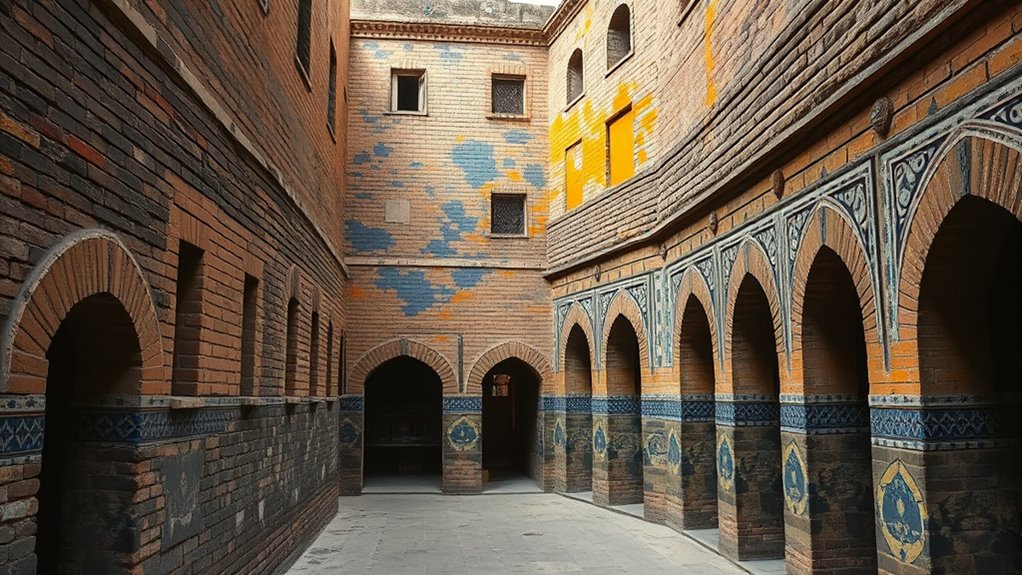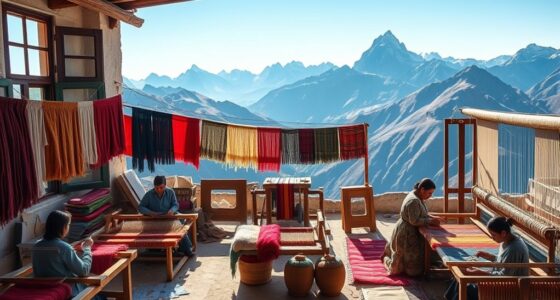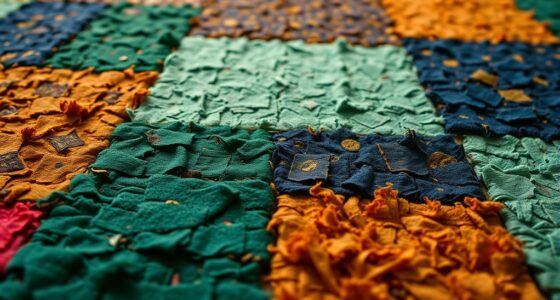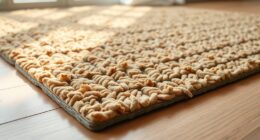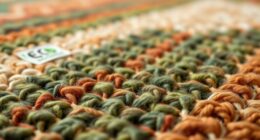Explore the vibrant world of Isfahan’s historic dye houses through fascinating images that showcase centuries of craftsmanship and cultural significance. Witness the architectural features designed for functionality, from courtyards to light-regulating windows, and see artisans at work blending natural dyes like indigo, madder, and pomegranate. Discover how these workshops reflect Persian traditions, colors, and daily life. Keep exploring to learn how these timeless practices face modern challenges and continue to inspire.
Key Takeaways
- Showcases the architectural design and functional layout of traditional dye houses in Isfahan.
- Highlights vibrant colors and intricate craftsmanship reflecting cultural symbolism and artistic heritage.
- Features close-up images of artisans working with natural dyes and detailed textile processes.
- Depicts bustling market scenes emphasizing the social and economic significance of dyeing districts.
- Addresses preservation challenges and efforts to sustain these historic dyeing traditions amidst modern changes.
The Origins and Historical Significance of Isfahan’s Dye Houses

Although dyeing techniques date back centuries in Isfahan, the city’s dye houses emerged as essential centers of craftsmanship during the Safavid period. Their distinctive dye house architecture reflects practical design choices that facilitated dyeing processes, such as open courtyards for natural ventilation. You’ll notice that these structures were built close to natural dye sources like indigo, pomegranate peel, and madder root, which provided vibrant pigments crucial for textile craftsmanship. These dye houses played a fundamental role in Isfahan’s economic and cultural history, fueling the city’s reputation for rich, colorful textiles. Their strategic location and thoughtful architecture allowed artisans to efficiently produce dyes, making the dye houses not just workplaces but hubs of innovation and tradition that have endured through centuries.
Architectural Features of Traditional Dye Workshops
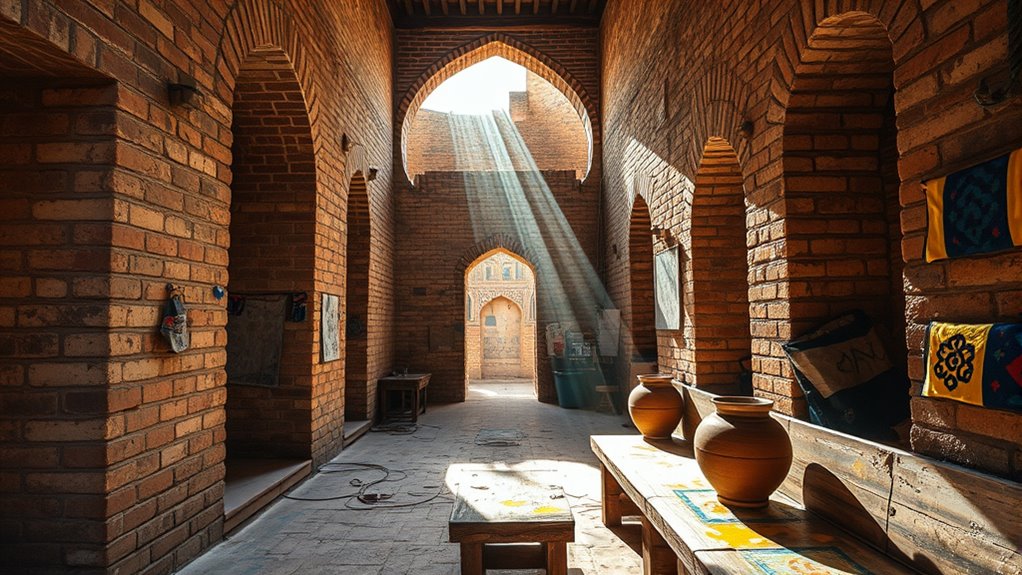
The architecture of traditional dye workshops in Isfahan reveals a thoughtful blend of functionality and regional craftsmanship. These structures feature historical architecture designed to optimize workflow and environmental conditions. You’ll notice that dye workshop layouts are organized to separate different stages of dyeing, such as washing, bleaching, and dyeing, ensuring efficiency and cleanliness. Thick mud-brick walls help regulate temperature, keeping the interior cool during hot days. Courtyards serve as central spaces for work and ventilation, while high ceilings allow hot air to escape. Small windows provide natural light without exposing delicate fabrics to direct sunlight. These design elements reflect a deep understanding of local climate and craft needs, creating spaces that are both practical and culturally significant. Additionally, the integration of automation in business principles can be seen in some modern adaptations, aiming to improve operational efficiency within traditional frameworks.
The Art of Natural Dyeing: Techniques and Materials
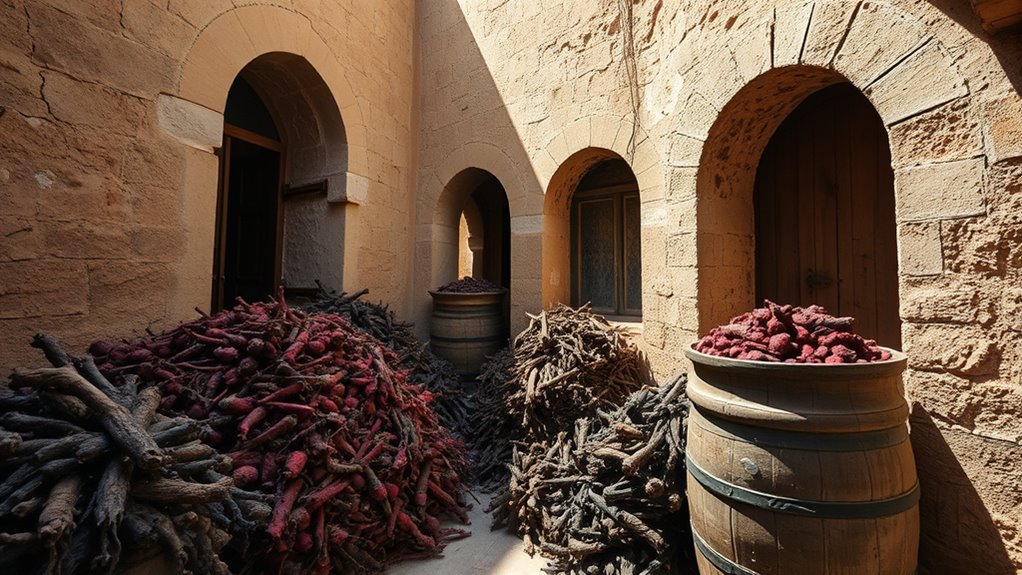
You can explore the rich world of natural dyeing by learning about the traditional materials used, like indigo and henna. Following a step-by-step process, artisans transform these materials into vibrant colors for textiles. Each hue holds cultural meaning, reflecting the history and identity of Isfahan’s dyeing traditions. Moreover, understanding AI security technologies can help preserve these traditional practices by safeguarding digital archives and intellectual property. Developing a comprehensive leadership approach can also support community efforts to protect and promote these cultural crafts. Additionally, integrating digital security measures ensures the integrity of data related to these historic techniques, helping to maintain their authenticity for future generations.
Traditional Dye Materials
Have you ever wondered how artisans in Isfahan achieved those vibrant, lasting colors in their textiles? They relied on traditional dye materials derived from natural pigments and botanical sources. These materials include:
- Indigo from *Indigofera tinctoria* for deep blues
- Madder root (*Rubia tinctorum*) for rich reds
- Henna leaves (*Lawsonia inermis*) for warm oranges and browns
- Pomegranate rinds for earthy yellows
- The wide color gamut of natural dyes enhances the visual richness and depth of the textiles. Additionally, the safety measures employed in traditional dyeing processes help preserve the integrity of these natural materials.
Step-by-Step Dyeing Process
To achieve vibrant, lasting colors in natural dyeing, artisans carefully follow a step-by-step process that transforms raw materials into beautiful hues. First, you prepare the fabric by soaking it in water and a natural mordant, like alum, to fix the dye. Then, you choose your dye source—plants for natural dyes or chemical dyes for brighter, faster results. You boil the dye material to extract color, then immerse the fabric until it reaches the desired shade. After dyeing, you rinse and dry the fabric. The process varies depending on the dye type, but precision in timing and temperature control is key to successful results. Additionally, maintaining proper color fixation techniques is essential to ensure the vibrancy and longevity of the dyed fabric. Properly preparing the mordant bath can significantly improve dye adherence and colorfastness. Consistent application of these methods helps in achieving color durability and resistance to fading over time. Maintaining consistency in these techniques can greatly enhance the durability of natural dyes and their resistance to fading over time.
Cultural Significance of Colors
- Red often symbolizes life, passion, and vigor.
- Blue represents spirituality, protection, and heaven.
- Yellow signifies wealth, fertility, and prosperity.
- Green embodies renewal, paradise, and harmony.
Understanding these meanings deepens your appreciation for natural dyes, as each hue carries layers of cultural significance. The choice of dye is not random but rooted in tradition and symbolism, making every color a story on fabric. Recognizing this enriches your connection to the history and artistry behind Isfahan’s historic dye houses.
Vibrant Colors and Their Cultural Meanings
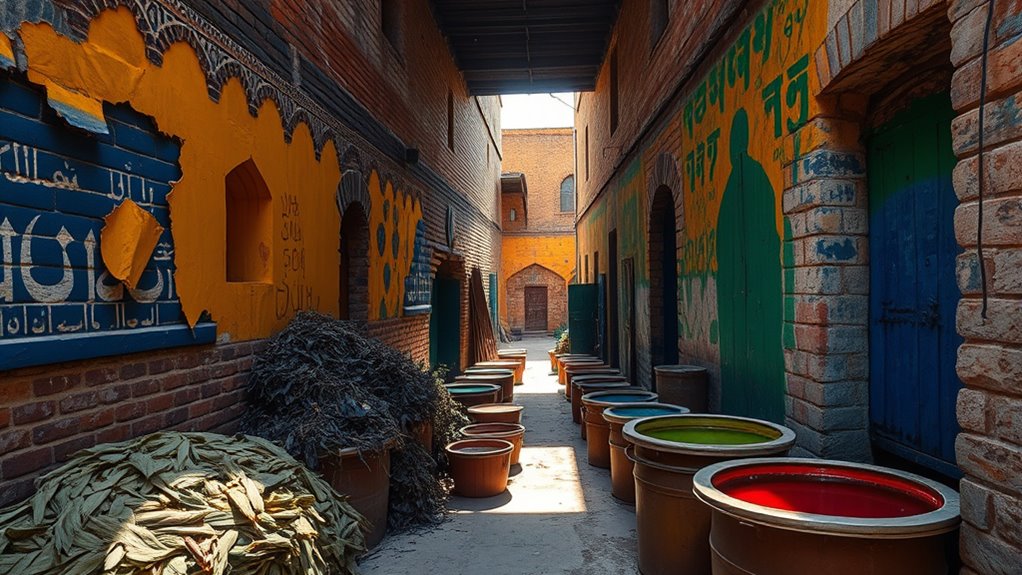
The vibrant colors used in the dye houses of Isfahan carry deep cultural significance that goes beyond their striking appearance. Each hue reflects specific color symbolism rooted in Persian traditions. For instance, red dye symbolizes vitality and passion, while blue represents spirituality and protection. These colors aren’t chosen at random; dye symbolism reveals their importance in conveying social and spiritual values. You’ll notice how artisans carefully select and blend dyes to evoke certain meanings, connecting the craft to cultural identity. The vivid reds, blues, and yellows are more than pigments—they embody stories, beliefs, and historical significance. An understanding of dye symbolism further enhances appreciation for their cultural importance. A visual representation of these colors helps contextualize their meanings within the broader framework of Persian cultural expressions. Understanding these vibrant colors helps you appreciate the rich cultural tapestry woven into the very fabric of Isfahan’s historic dye houses.
Daily Life and Workforce in the Dyeing Districts
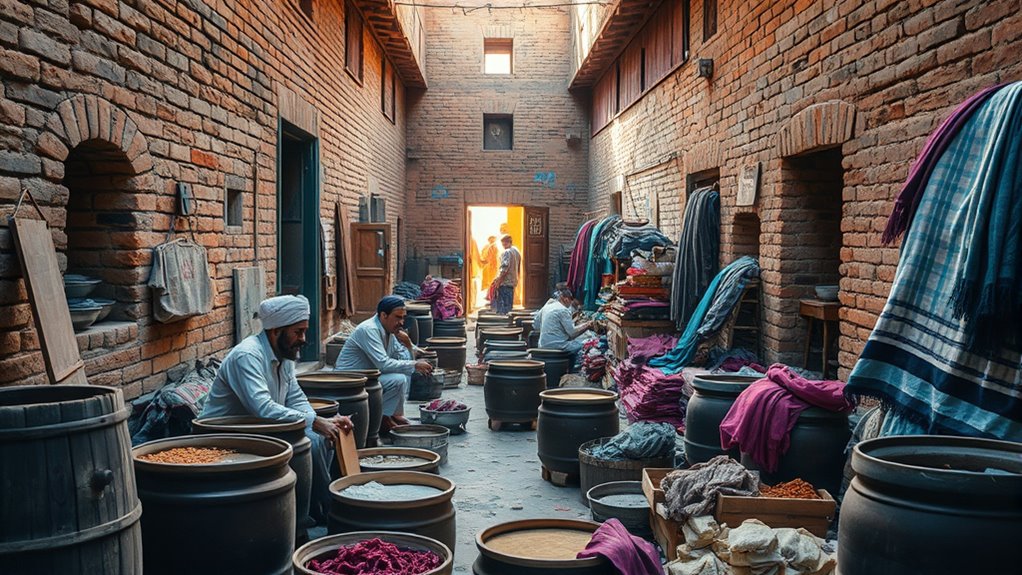
Every day in Isfahan’s dyeing districts begins with a flurry of activity as artisans and workers prepare for their tasks. You notice how the dye house architecture supports efficient workflows—open courtyards, high ceilings, and large windows for ventilation. The workforce’s daily routines follow a clear rhythm:
- Gathering raw materials at dawn
- Preparing dye baths with precise measurements
- Stirring and monitoring color consistency
- Washing and drying finished textiles
Workers move swiftly, their coordinated efforts essential to maintaining the vibrant hues that define these districts. The design of each dye house facilitates teamwork and safety, reflecting centuries of tradition. You also observe how dye house materials such as ceramic and recycled products are used in some structures to enhance durability and sustainability, contributing to the overall environmental impact of the industry. Additionally, the use of traditional craftsmanship techniques ensures the preservation of cultural heritage in these practices. To support sustainable practices, some workshops incorporate eco-friendly methods, which are becoming increasingly important in modern textile industries. Modern innovations like natural dye extraction techniques are also being adopted to reduce chemical use and minimize pollution. As you observe, you realize how these elements combine to sustain the vibrant dyeing culture that’s deeply rooted in Isfahan’s history.
Preserving Artistic Traditions in a Modern World
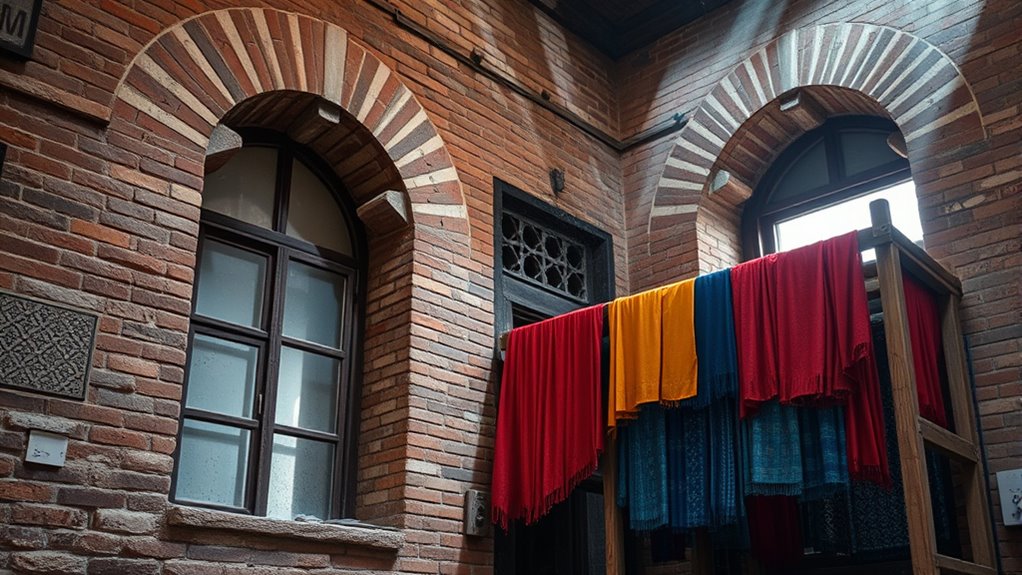
You can see how traditional dyeing techniques still flourish despite modern pressures. These practices hold deep cultural significance that many endeavor to preserve. Yet, ongoing challenges threaten to erode these artistic traditions, making their preservation more urgent than ever.
Traditional Techniques Endure
Although modern technologies have transformed many industries, traditional dyeing techniques in Isfahan continue to thrive thanks to dedicated artisans who value their cultural heritage. You’ll notice they rely heavily on natural pigments, carefully sourced from plants, minerals, and insects. Their workshop techniques emphasize patience and skill, guaranteeing each dye process preserves authenticity. Here are four ways they keep these traditions alive:
- Using age-old recipes passed down through generations
- Maintaining small-scale, hands-on workshop environments
- Prioritizing natural pigments over synthetic alternatives
- Training new artisans to master traditional methods
These efforts ensure that the vibrant colors and intricate patterns remain rooted in history, blending craftsmanship with cultural pride. Your appreciation grows as you witness firsthand how these artisans keep their heritage alive through every dye bath.
Cultural Significance Maintained
The dedication of Isfahan’s artisans guarantees that their vibrant dyeing traditions remain meaningful amid modern influences. They preserve color symbolism, where specific hues represent cultural values and spiritual beliefs, ensuring these meanings stay alive through generations. By maintaining dye sustainability, artisans show respect for the environment while honoring their heritage. Their commitment keeps traditional techniques relevant, allowing contemporary audiences to connect with the history embedded in each hue. You see this in the careful selection of natural dyes and the intricate processes that uphold authenticity. These practices serve as a bridge between past and present, reinforcing the cultural importance of dyeing as more than just decoration. Instead, it becomes a living expression of identity, history, and community that withstands the pressures of modernization.
Modern Challenges Faced
Modernization poses significant challenges to the preservation of Isfahan’s traditional dyeing crafts, as rapid technological advances and changing consumer preferences often favor mass-produced textiles over handcrafted artistry. Modern urbanization reduces the space and resources available for dye houses, making it harder to maintain traditional practices. Environmental concerns also threaten these crafts, with pollution and chemical use impacting dyeing processes. To adapt, you must consider:
- Integrating eco-friendly dyes and sustainable practices
- Educating younger generations on traditional techniques
- Promoting cultural tourism to generate income
- Balancing modernization with conservation efforts
These steps are essential to safeguard the artistic heritage amid shifting social and environmental landscapes, ensuring that the legacy of Isfahan’s dye houses endures in a modern world.
The Role of Dyes in Persian Textile Art and Craftsmanship
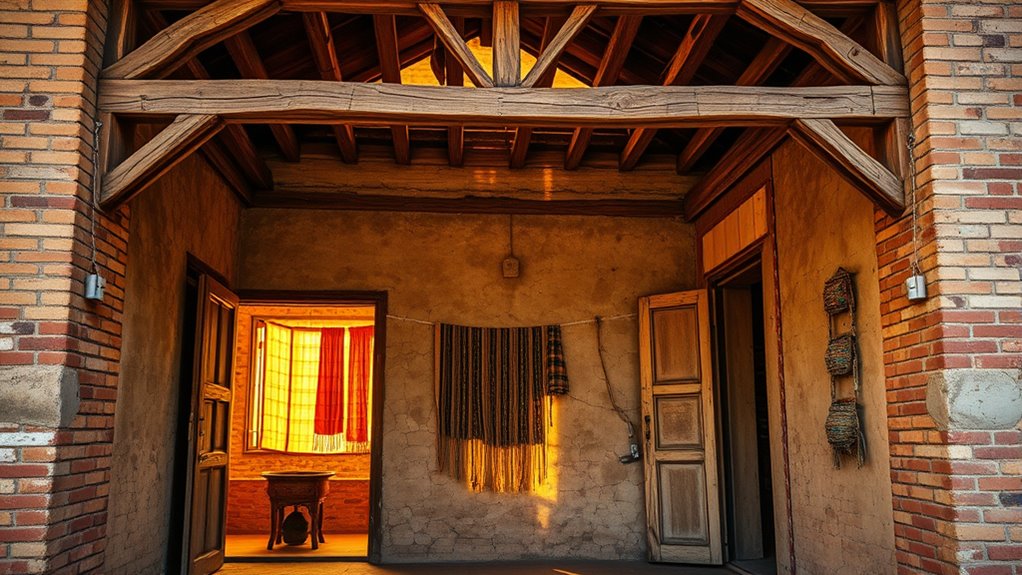
Dyes have long been the heartbeat of Persian textile art, shaping the vibrant colors that define its craftsmanship. Traditional dyes like indigo, madder, and pomegranate created rich hues that artisans prized. Today, synthetic dyes and modern technology influence the process, offering faster, more consistent results. These advances make dyeing more efficient but sometimes challenge the authenticity of historic techniques. You can see how artisans balance tradition with innovation, blending natural methods with new materials. The table below highlights key dyes used historically and today:
| Dye Type | Natural Source | Modern Substitute |
|---|---|---|
| Indigo | Woad or Indigo plant | Synthetic indigo |
| Madder | Root of Rubia tinctorum | Synthetic red dye |
| Pomegranate | Pomegranate peel | Commercial dyes |
| Cochineal | Dried insect bodies | Synthetic crimson |
Challenges Facing the Preservation of Historic Dye Houses

Preserving historic dye houses faces numerous challenges as urban development, neglect, and environmental factors threaten their survival. Modern technology offers tools like 3D scanning and digital documentation, but outdated structures remain vulnerable. Urban development often pushes for new construction, risking the destruction or alteration of these historic sites. You must also contend with neglect, where lack of maintenance accelerates deterioration. Ultimately, environmental factors such as pollution, humidity, and temperature fluctuations accelerate decay. The main challenges include:
- Urban development encroaching on historic sites
- Insufficient funding for preservation efforts
- Environmental damage from pollution and climate factors
- Limited use of modern technology for restoration
Addressing these issues requires a balance of innovation, policy, and awareness to safeguard Isfahan’s dyeing heritage.
Personal Stories From Craftsmanship Elders

The voices of craftsmanship elders breathe life into the history of Isfahan’s dye houses, offering firsthand accounts of techniques, traditions, and the evolving challenges they’ve faced. As you listen, you realize how deeply color symbolism influences their work—each hue representing cultural values, spiritual meanings, or social status. These artisans’ stories reveal generations of skill passed down through oral tradition, preserving techniques that date back centuries. They share how natural dyes, like indigo and madder, require patience and precision, shaping their craftsmanship and identity. Their personal narratives highlight the importance of maintaining these traditions amid modern pressures, emphasizing that dyeing is more than a craft—it’s a reflection of cultural memory and community identity that they endeavor to uphold.
Capturing the Spirit: Photographic Highlights of Isfahan’s Dye Districts

Stepping into Isfahan’s dye districts, you’re immediately immersed in a vibrant tapestry of colors and bustling activity captured through the lens. The photographs reveal the rich symbolism behind each hue, from deep blues representing spirituality to fiery reds symbolizing importance. You notice four key elements:
- The intricate dye formulation process, blending natural ingredients with skill.
- Close-ups of hands mixing vibrant dyes, showcasing craftsmanship.
- Wide shots of bustling markets, emphasizing color symbolism.
- Portraits of artisans, capturing the spirit behind each stroke.
These images highlight the essential role of dye formulation in creating meaningful colors and preserving tradition. Through your lens, you see how each photograph captures the essence of Isfahan’s dye districts—an enduring legacy woven into the city’s cultural fabric.
Frequently Asked Questions
How Have Dyeing Techniques Evolved Over Centuries in Isfahan?
You might notice that dyeing techniques in Isfahan have evolved from traditional methods using natural pigments to more advanced processes over centuries. Today, artisans focus on textile preservation, ensuring that historic colors and patterns remain vibrant. While modern technology has introduced synthetic dyes, many still cherish natural pigments for their authenticity and cultural significance, blending old and new to keep Isfahan’s dyeing heritage alive.
What Are the Environmental Impacts of Traditional Dyeing Methods?
You might not realize it, but traditional dyeing methods can impact environmental sustainability by producing chemical pollution. These practices often use natural dyes, but sometimes involve harmful chemicals that pollute water sources and harm ecosystems. By understanding these impacts, you can support or advocate for more eco-friendly techniques, ensuring the preservation of cultural heritage while reducing chemical pollution and safeguarding the environment for future generations.
Are There Any Modern Adaptations or Innovations in Dyeing Practices?
Thinking about modern dyeing practices is like watching a river find new paths. You’ll find that many use synthetic dyes, which offer brighter, more consistent colors. However, eco-friendly innovations are also gaining ground—such as natural dye extracts and low-impact processes—that reduce environmental harm. These advancements help balance vibrant results with sustainability, allowing you to enjoy colorful fabrics while caring for the planet.
How Do Dye Houses Influence Local Community Identities?
You see that dye houses influence local community identities by fostering a sense of cultural significance and community pride. They serve as a hub where traditions are preserved and passed down, strengthening bonds among residents. When you visit or learn about these dye houses, you notice how they embody local history and craftsmanship, making them integral to the area’s identity and contributing to a collective sense of belonging and cultural continuity.
What Efforts Are Underway to Promote Dyeing Heritage Among Youth?
Think of vibrant threads weaving the future of tradition. You can see efforts like dyeing workshops and youth engagement programs shaping this fabric. These initiatives invite young people to learn dyeing techniques, preserving the art and fostering pride in their heritage. By actively participating, you help keep the colorful history alive, turning it into a living, breathing part of the community’s identity for generations to come.
Conclusion
As you explore Isfahan’s historic dye houses, you step into a living museum that blends centuries-old craftsmanship with today’s struggles. These vibrant workshops, like ancient code repositories, hold stories of culture, resilience, and artistry. Preserving them requires more than just a swipe on your smartphone; it’s about safeguarding a legacy that connects past to future. If only we could upload their history directly into our memories, ensuring their colors never fade into the digital ether.
